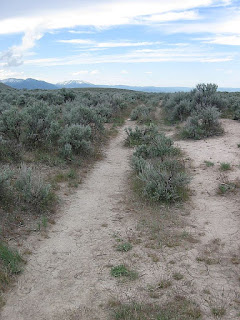 |
| The nature trail at Starvation Creek |
Unless they have to use the restroom, most travelers speed by Starvation Creek State Park at Exit 54 on eastbound Interstate 84. The patk is better known for its restroom facilities than it is for its nature hikes. But there’s a short, handicapped accessible trail which starts at the restrooms.
Starvation Creek Has Short Nature Walk
The trail starts at the north end of the restroom building and makes a loop through a heavily wooded area. Starvation Creek runs through the middle, babbling and rushing its way to the Columbia River on the other side of the freeway. In some places the path is a little steep, but easily doable for travelers who take their time. There are picnic tables along the way to enjoy a snack. The forest blots out the sound of the freeway, adding to the serenity of the picture.
It takes about 10 minutes to walk the loop of this roadside nature trail. Travelers with more time can take longer hikes up the Mt. Defiance Trail to see several waterfalls. The park is at the trailhead of the Mt. Defiance Trail. Other hiking opportunities are nearby.
Park Part of Historic Columbia River Highway
Signs at the site denote this is part of the historic Columbia River highway system. A plaque at the site says construction of the highway started here in 1912.
The park’s name, Starvation Creek, dates back to 1884 when a train en route from The Dalles to Portland became snowbound when avalanches blocked it at both ends. According to the Oregon State Archives website, the Pacific Express, carrying 148 people, became stuck in the snow on December 18, 1884, during a particularly bad snow storm. Rescuers reached the train on Christmas Day, but it was not until a week later that the train was able to move. It went back to The Dalles, finally reaching Portland three weeks behind schedule. Passengers reportedly were more in danger of freezing from the winter cold, burning train seats to keep warm, than they were of starving. The archives notes a pig on the train did not survive the trip.
No Westbound Freeway Access to Starvation Creek Park
Starvation Creek State Park is open for day-use only, though the restrooms are open around the clock. The park is accessible only by eastbound travelers. Westbound travelers will need to continue down the freeway a few miles then cross to the eastbound lanes and double back to Exit 54. Another option is for westbund travelers to get off at Viento State Park, then walk the two miles to Starvation Creek.




















